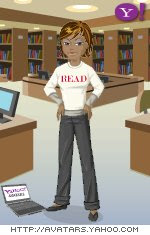The CSM Library 2.0 Team modified The Learning 2.0 program designed by Helene Blowers, Technology Director, Public Library of Charlotte & Mecklenburg County. The tutorial contains links and offers suggestions for ways to incorporate these tools into your campus and online courses and professional collaborations. The design of this online program was completely built on Web 2.0 technologies that are freely available on the Internet. For example, sites include: Blogger, Flickr, Odeo, YouTube, PBWiki & Bloglines.
Frequently Asked Questions:
- How does this online learning program work? This is a self-discovery program which encourages participants to take control of their own learning and to utilize their lifelong learning skills through exploration and play. Participants are encouraged to work together and share with each other their discoveries, techniques, and "how to's" both in person and through their blogs. This course is web-based and not tied to any particular computer.
- Is this program open to everyone or just some? This program is open to all who want to learn and grow. Participate individually or as a group. The benefit to participating as a part of a group is that you cheer one another along. Participants tell us this is incredibly rewarding and also a way to learn from one another. Don’t we all like positive reinforcement?
- How long do I have to complete the program? This is a 9 week program. The idea is that you work on a new “thing” or activity each week. However, you may work ahead or take a week off here and there. It is up to you how fast you decide to work!
- How do I track my progress for the 23 Things? You will be asked to make a blog of your own to track your progress. Please use your blog to write your reactions to the lessons and add any ideas you may have on how to use web 2.0 tools for yourself and the CSM campus. This is YOUR time to experiment, have fun, and learn at your own pace. Web 2.0 is here....and now, so are we! We recommend you to label your blog posts this way: Include THING # [1-23] in the heading of each post. It will help you track your progress. It is also helpful when you want to refer back or add something new on a specific topic or tool.
- WEEK 7 is Wiki Week. We have created a CSM Learning 2.0 wiki especially for you, so when you learn a new 2.0 application and use it in a special way, you can add and share that "2.0 Best Practice." Participants are welcome to contribute to the wiki as they move through the 9-week course, or can wait until WEEK 7. It is your choice. Just "copy and paste" your applications into the wiki.
- Will there be any training classes? No, this is a self-directed learning program. We will provide helpful hints, encouraging words, and post comments from time to time. You are also encouraged to be resourceful and to find a co-worker or another staff member who can help. Be sure to share your knowledge and expertise too! The CSM 2.0 Team will be available by e-mail to answer your questions. If you would like a workshop to “kick-off” your experience, let us know and we can add some face-to-face (f2f) learning. The more ways to learn, the merrier.
- Is there any tech support? What tech support do you have now? At work? On campus? At home? At your local coffee shop or library? If you run into difficulties, and have done some serious problem solving and still have a question, ask the CSM 2.0 Team. We can assist you with the course, but not your computer or Internet connection. Also, check out our “Weekly Tips” page.
- Why Do This? Web 2.0 is a phrase that was coined in 2004. It refers to the fact that the Internet is now an interactive medium rather than a ‘place’ to go to get information. Since it is the young who are flocking to these Web 2.0 sites, it is important that those of us who work in education should be up-to-date with the latest trends in education and technology and learn how they can be utilized in or with our classrooms and school libraries. In April 2007, at the Computers in Libraries Conference the keynote speaker was Lee Rainie, Founding Director of the Pew Internet and American Life Project The title of his keynote was: “Web 2.0 and What it Means to Libraries.” In this presentation, he spoke about six “hallmarks” of the Web 2.0 world that matter to libraries. These hallmarks outline the important fact that more and more Internet users are using the Internet to make connections, contributing their ‘know-how’ and customizing their experiences on the web.
Hallmark #1: The Internet has become the computer;
Hallmark #2: Tens of millions of Americans, especially the young, are creating and sharing content online;
Hallmark #3: Even more Internet users are accessing the content created by others;
Hallmark #4: Many are sharing what they know and what they feel online and that is building conversations and communities;
Hallmark #5: Tens of thousands are contributing their know-how and/or their processing power to the online commons;
Hallmark #6: Online Americans are customizing their online experiences thanks to Web 2.0 tools.
It is because of these “hallmarks” that the CSM 2.0 Team offers this fun professional development tutorial for you! - Who are members of the CSM 2.0 Team? CSM 2.0 Team leaders are Lorrita Ford, Teresa Morris, Jackie Siminitus, and a number of other CSM faculty. All participants who successfully complete CMS Learning 2.0 become members of the CSM 2.0 Team. Let’s grow our campus 2.0 team.

